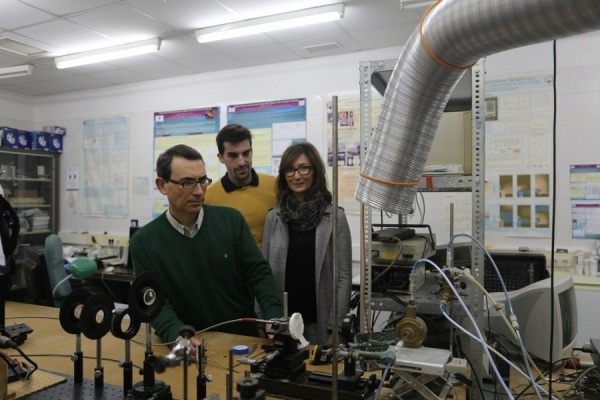Two UCO research groups designed a plasma (an ionized gas) reactor maintained by microwaves that make it possible to decontaminate waters with high concentrations of dye.

Researchers Francisco J Romero, Juan Amaro y María C García Image Credit: Universidad de Córdoba
Ionized gases, such as plasma, are made up of electrons, ions, atoms, molecules, radicals, and photons. It is referred to as the fourth state of matter frequently, and, oddly, it is present in everything. Not only do fluorescent tubes light kitchens artificially by transmitting energy to a gas, but the team has also made it possible for mobile phones to get smaller and smaller.
The use of plasma in technology has truly revolutionized the field. It is necessary to use chemical products that are harmful to the environment to engrave the circuits on the silicon plates used in electronic devices such as mobile phones. Now that plasma has been used, this can be done more accurately and cleanly because the slits and devices can be made smaller and smaller together.
However, plasma can also be used in other ways, like treating water. The University of Cordoba’s FQM-136 Physics of Plasmas and FQM-346 Organic Catalysis and Nanostructured Materials groups worked together on a study that aimed to remove pollutants from water by using plasma to stimulate chemical reactions.
These researchers chose to apply plasma in order to address the issue of the growing amount of organic pollutants in waters, such as dyes and other substances from industrial and agricultural activity in waters that upset ecosystems.
In 2017, researchers showed for the first time that argon plasmas produced by microwaves exposed to the atmosphere could react with water to create reactive species that contained nitrogen and oxygen. These species included hydroxyl radicals, nitrogen radicals, and hydronous peroxide, and the species could potentially clean the water.
By designing a reactor of this kind and greatly increasing the amounts of these active species generated in water, researchers Juan Amaro Gahete, Francisco J. Romero Salguero, and María C. García have now made it possible to destroy high concentrations of dyes (in this case, methylene blue) in a matter of minutes.
This was achieved by altering the design of the surfatron, the metal device that mixes the energy from a microwave generator with the plasma to maintain it.
What we’ve done is to place a small piece of silicon in the quartz discharge tube, allowing a different plasma to be generated, one that is not filamentary and is more efficient at creating active species when interacting with water.
María C. García, Professor, Universidad de Córdoba
The aforementioned plasma components, when interacting with water, generate oxidizing species capable of degrading organic compounds and killing microorganisms, which allows this plasma reactor to be used in applications related to water remediation.
This new configuration, therefore, expands the applicability of this type of plasmas.
The design completely changes the configuration of the electromagnetic field generated by the surfatron to create the plasma, resulting in plasma with different and more efficient properties, also eliminating the problem of filamentation (the division of the plasma column into many filaments), which destabilizes it.
María C. García, Professor, Universidad de Córdoba
And then...decontamination.
Those oxidizing species generated due to the action of plasma are very reactive and make it possible to destroy the organic matter inside the water. For this to happen, the plasma is not introduced into the water. Rather it is made to act remotely so that between the water and the plasma there is a zone of air where numerous reactions occur due to collisions between the excited species and the molecules of oxygen, nitrogen and water vapor, and reactive species that diffuse into the liquid and end up with the contaminants are generated.
Francisco J. Romero, Professor, Universidad de Córdoba
The decontaminating potential of this type of plasma, generated with this new design “has been tested to reduce high concentrations of methylene blue dye in water, with very efficient results in terms of energy, achieving the complete elimination of the dye at reduced treatment times,” says Juan Amaro.
With this work, one of the applications of plasma - the “fourth state of matter” created by supplying energy to a stable gas and transforming it into an ionized gas - becomes closer to reality. Applications for plasma include the production of microchips, surface disinfection, wound healing, anti-reflective coatings for glasses, waste recovery, seed germination enhancement, activating plastic surfaces to improve paint adhesion, and a plethora of other uses.
Journal Reference
Amaro-Gahete, J., et al. (2024) Modified surfatron device to improve microwave-plasma-assisted generation of RONS and methylene blue degradation in water. Chemosphere. doi.org/10.1016/j.chemosphere.2023.140820